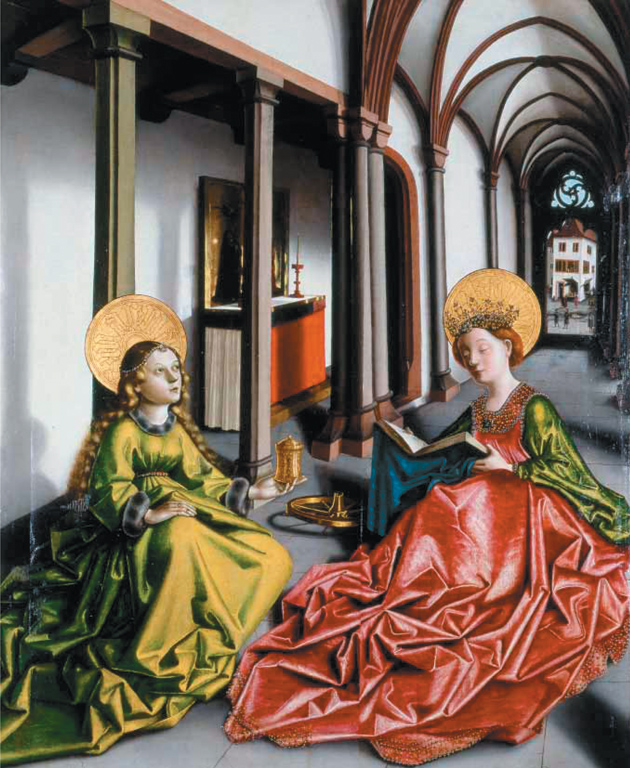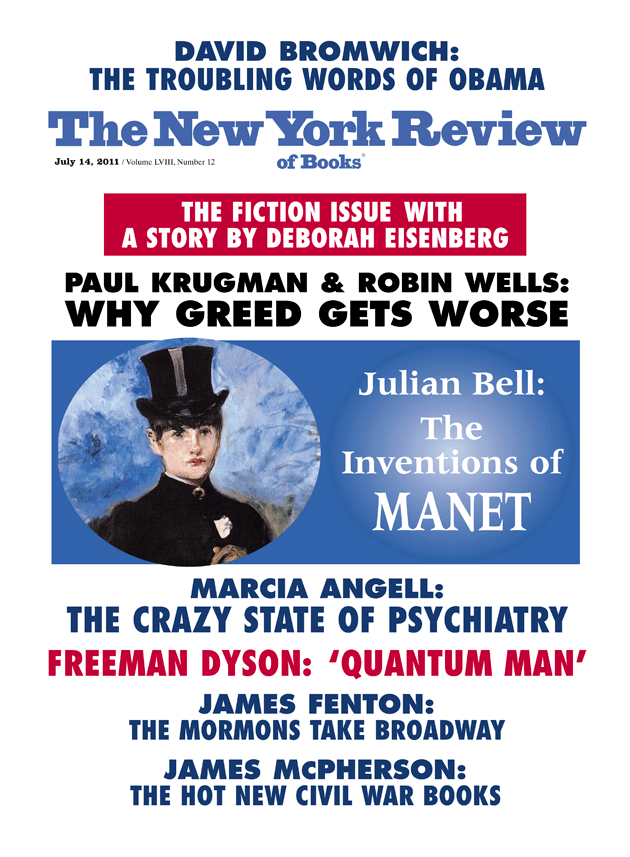Twenty years after German reunification a notable aesthetic and emotional shift is under way, a rediscovery of the expressive character that sets Germanic art apart from the more polished, harmonious creations of its neighbors to the west and south. This shift is evident in the reawakened interest in neglected or forgotten German painters and sculptors from the first third of the twentieth century. But the history of older German art is also reemerging from neglect. This summer brings a new show in Naumburg devoted to the once famous “Naumburg Master,” whose sculptures had been almost forgotten in the postwar years. Late medieval German painting, too, has had a great part in this sentimental renaissance. Recently we had the opportunity to marvel at the Gray Passion of Hans Holbein the Elder in a monumental show in Stuttgart. Now comes an even greater sensation: the Kunstmuseum in Basel has mounted an ambitious show of the work of Konrad Witz.
Konrad Witz is one of the most suggestively powerful yet biographically mysterious masters of older German art. We do not know when he was born. He came from the Swabian town of Rottweil where his father is listed as “Hans the Painter” in tax records from 1433. But where did the younger Witz learn his art? Rottweil, on the upper Neckar River between Freiburg and Stuttgart, was not exactly a center of artistic training. By the time he is mentioned in a document from Basel in 1434, he is called “Master Konrad of Rotwil,” which suggests that his apprenticeship was already completed. He was granted Basel citizenship in 1435, was paid for murals in the municipal granary in 1441 and 1442, and by 1443 was sufficiently well-to-do to purchase a house in the center of town for the considerable sum of 350 guilders. In contrast to this documentation of his presence is the unnerving fact that there is not a single surviving work from Konrad Witz’s years in Basel that can be unquestionably attributed to him.
The only piece that is his beyond a doubt resides in western, francophone Switzerland. In 1444 he signed the Saint Peter altarpiece in the Geneva cathedral, “hoc opus pinxit magister conradus sapientis de basilea“—“Master Konrad Witz [“wit,” “reason,” or “understanding” in German] of Basel painted this work.” It was a prominent commission. Saint Peter is the patron saint of the Cathedral of St. Pierre. Cardinal François de Metz, resident bishop of Geneva since 1436, appears as the donor of the retable. It may be that Witz’s work had caught his eye when he attended the Council of Basel in 1431. The Saint Peter altarpiece was a late work of the master; a document of 1447 mentions his wife as a widow.
On the basis of this scant documentary evidence, comparative art historians over the last hundred years have through attribution constructed a distinctive oeuvre for him. Late medieval German painting has always been a happy hunting ground for attributors who delight in inventing names for anonymous masters and arguing about their works with detective zeal.
Surprisingly, this impressionable branch of scholarship has been making a comeback and the new show in Basel—where visitors can gaze at works by the “Master of 1445” and the “Master of Sierentz”—also owes its existence to the devoted efforts of the scholars of attribution. It is only a medium-size exhibition, occupying fewer than ten galleries, and most of the works come from the so-called orbit of Konrad Witz. The Geneva altar could not be included because of conservators’ fears for its fragility. The panels attributed to Witz from his years in Basel constitute the show’s core. And indeed, they display a coloristic intensity and rugged glitter to be found nowhere else in older German painting. That alone makes them worth the trip.
The twelve panels of a winged retable from a church in Basel—perhaps the Augustinian monastery of St. Leonhard—make up the largest part of those works. Their exterior surfaces show solitary figures whose shadows fall on the gray walls of unadorned stone interiors. In their striking sculptural power they are both intensely present and spectral. The dramatic high point is an allegorical figure of the Synagogue in a robe of noxious yellow. Her right hand presses the Tablets of the Law to her breast, in her left she holds a broken flagstaff, and the blood has drained from her pale face. Only a few years earlier, the sweetness of the “soft style” had set the tone for painting along the upper Rhine, the region that produced the Paradiesgärtlein (circa 1410), “The Little Garden of Paradise” in the Städel Museum in Frankfurt. The pictures of Konrad Witz were an abrupt break with this tradition. They have something of the new hardness that was also emerging under quite different circumstances in Florence in the works of Masaccio and Donatello.
Advertisement
The interior surfaces of the winged altar are far more brilliant and exciting. Here ecclesiastical tradition required gilt backgrounds to evoke the aura of eternity. Against this immaterial foil appear paired figures in costly clothing—brocade and fur trimmed in jewels and gold—with exotic headgear and gleaming armor. They depict stories from the Old Testament, but also pseudo-antique legends collected in the late medieval Heilsspiegel, the Speculum Humanae Salvationis (Mirror of Human Salvation). The latter are not usually encountered as images above an altar. Scholars have labored on various reconstructions of the entire retable but their efforts have not produced any completely convincing results.
These striking and unusual subjects apparently stimulated Konrad Witz’s artistic imagination. He makes the most of the arrangement of the folds and the colors of their strange garments, especially the red tones: purple, crimson, and pink. Highlights flash from suits of armor and gold glistens on the hilts and crossguards of swords. Yet his kings and knights are by no means elegant. There is something occasionally stolid and inert about their faces and gestures, yet that is also precisely what lends them their naive and unlovely intensity.
The new painting style of the fifteenth century, which discovered the visible world and invented a mirror for its material and colorful representation, stood in historical opposition to the transcendent, spiritual subjects whose recollection and preservation the Church continued to demand. The witty Erwin Panofsky attempted to gloss over this historic contradiction in Netherlandish painting with the clever formula “disguised symbolism.” But there is hardly another instance in religious painting from the dawn of the modern era where we encounter such a stark, unreconciled contrast between the worldly and the otherworldly as in Konrad Witz’s Heilsspiegel altar. The gold foil still gleams in the background, but before it rise figures we feel we could reach out and touch and whose blazing colors delight our eyes.
King David towers beside his throne dressed in a brocade robe trimmed with jewels. Abishai kneels before him in a black and gold surcoat over his glistening silver armor. Sacred painting seems to celebrate itself here in an emphatic demonstration of its new power to enchant and beguile our vision.
But even the panels of the Heilsspiegel altar are outshone by three pictures of probably somewhat later date. A panel whose separate halves reside today in Nuremberg and Basel shows on its exterior surface an Annunciation and on the interior the encounter of Joachim and Anne at the Golden Gates. The catalog’s conjecture that this wing was part of an altar in Olsberg in eastern Switzerland is not well supported, but the intensity of its artistic power is beyond dispute. While the Netherlandish masters staged the Annunciation in sumptuous chambers, Witz directs our gaze into an empty, unadorned room with a plank floor and a wooden ceiling supported by rough-hewn posts. The angel, an enormously serious and not at all sweet figure with a pale face and staring eyes, has just entered through a closed door with an iron handle. The Virgin Mary sits on the hard floor without a cushion. She has been interrupted at her prayers and, startled, turns to listen. Shadows play on the floor and walls and the sacred annunciation almost takes on the air of a witching hour. The spirituality of the heavenly tidings is completely embedded in the earthly and material; the transcendent has arrived in the world.
The third picture has a different character and must be declared the highlight of the show. It is a single panel of unknown provenance from the Strasbourg museum. We look down the side aisle of a church and out into the street where a house with open shutters can be seen. One could call this an early architectural painting. But then there is another abrupt contrast: dominating the foreground, two venerated female saints sit solemnly on the floor of the side nave. On the left we see the penitent Mary Magdalene in a dress of warm green with her shiny golden hair worn loose. In her left hand she presents the vessel from which she once anointed the Savior’s feet. Next to her sits a majestic Saint Catherine, princess and martyr, engrossed in a sacred text and wearing an intoxicatingly beautiful festive dress of crimson material. At her side gleams the golden wheel on which her persecutors failed to break her. Here, Witz once again raises to the level of paradox the contrast between the worldly and the transcendent and leaves us baffled. Painting itself becomes the miracle.
It is a déformation professionelle of art historians to look for influences. Konrad Witz is one of the riddles of the history of German art in the fifteenth century because the derivation of his painting, so revolutionary on the upper Rhine, remains obscure. This makes the connoisseurs uneasy. Did he drink from the most powerful contemporary source, the Netherlandish masters painting in Bruges and Ghent? It is very tempting to think so, and the catalog conjecturally places the Swabian apprentice in front of the Ghent altarpiece of Jan van Eyck, but this is only a Romantic dream of the kind conjured by Ludwig Tieck in his novel The Wanderings of Franz Sternbald. Konrad Witz’s harsh contrasts and starkly sculptural forms are in decided opposition to van Eyck’s more cultivated and subtle use of space, light, and atmosphere.
Advertisement
We must instead look to the south, to Provence, where an independent variant of early Netherlandish style, also characterized by sculptural forms, had developed under Count René d’Anjou. The show includes a wonderful mon- umental panel of the prophet Isaiah that was once part of an altar in the cathedral of Aix-en-Provence. Here the kinship with Witz is evident in the plastic form, the fall of the folds, and especially in the shadow on the wall. Did the apprentice from Rottweil ramble around Savoy and Provence? Whatever the case, Witz’s naive, almost fairy-tale, and sometimes awkward expressiveness remains untraceable. And so we end where we began, a bit perplexed and astonished at the unique character of German art—and of course, a bit skeptical as well.



